The Glass Packaging Market is estimated to be valued at USD 75.07 Bn in 2025 and is expected to reach USD 100.87 Bn by 2032, exhibiting a compound annual growth rate (CAGR) of 4.3% from 2025 to 2032.
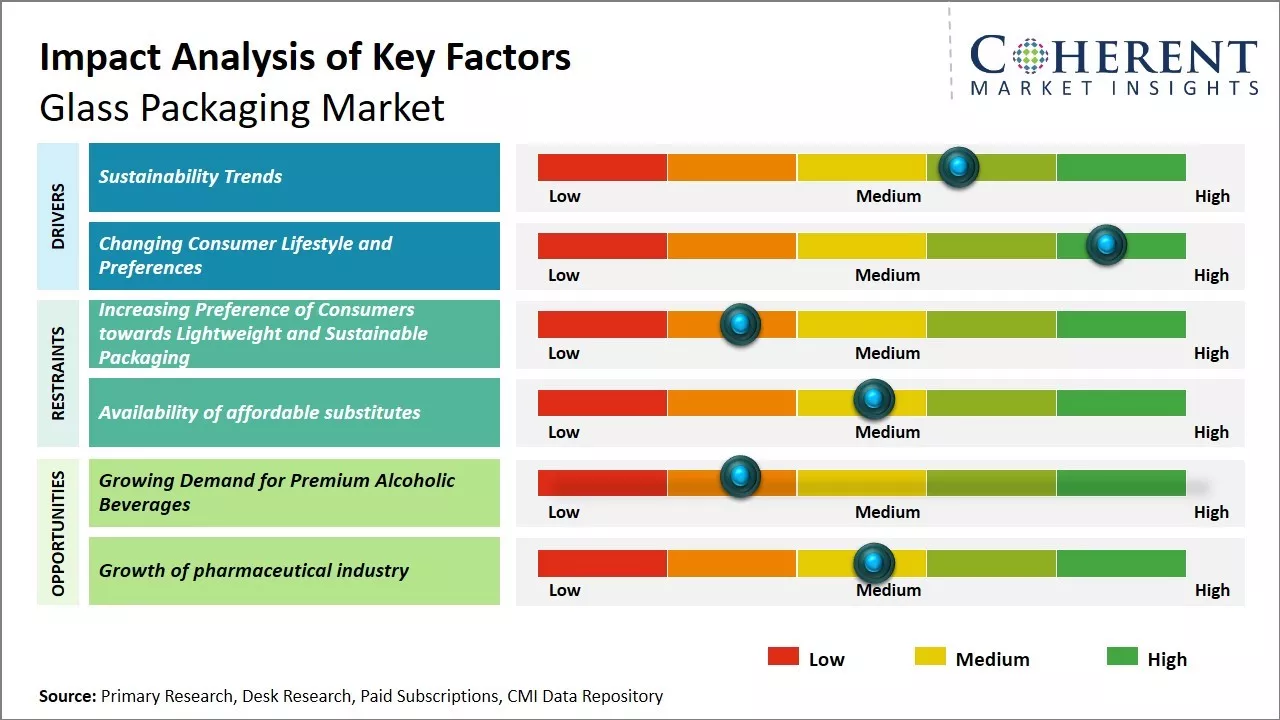
Discover market dynamics shaping the industry: Request sample copy
The glass packaging market is expected to witness significant growth over the forecast period. Glass is considered as one of the most sustainable packaging materials used for beverages and food products. Glass does not leach chemicals into the products due to which it is highly preferred for the packaging of premium food and beverages. The increasing demand for premium alcoholic and non-alcoholic beverages is expected to drive the growth of the glass packaging market. However, glass is heavier in weight as compared to other alternatives like plastic which increases the cost of transportation. The development of lightweight glass packaging solutions through technological advancements provides growth opportunities for the players in the glass packaging market over the coming years.
Sustainability Trends
The rising awareness about environmental protection and sustainability has significantly impacted consumer preferences and buying behaviors across the globe. There is a growing segment of conscious consumers who consider the environmental and social impact of the products and packaging solutions used. Glass is emerging as one of the most sustainable packaging formats owing to its high recyclability rate and infinite recyclability property. Glass can be recycled endlessly without any loss in quality or purity. This prevents glass containers from ending up in the landfills or incinerators. The recycled glass content can be utilized again and again to manufacture new glass packaging products. With sustainability becoming a key agenda of packaging producers, they are increasingly preferring glass as the material of choice. The recyclability and reusability features allow manufacturers lower carbon footprint of their packaged products and meet the demand of eco-conscious consumers. This growing emphasis on sustainable packaging is steering the demand for glass containers especially for food and beverage applications.
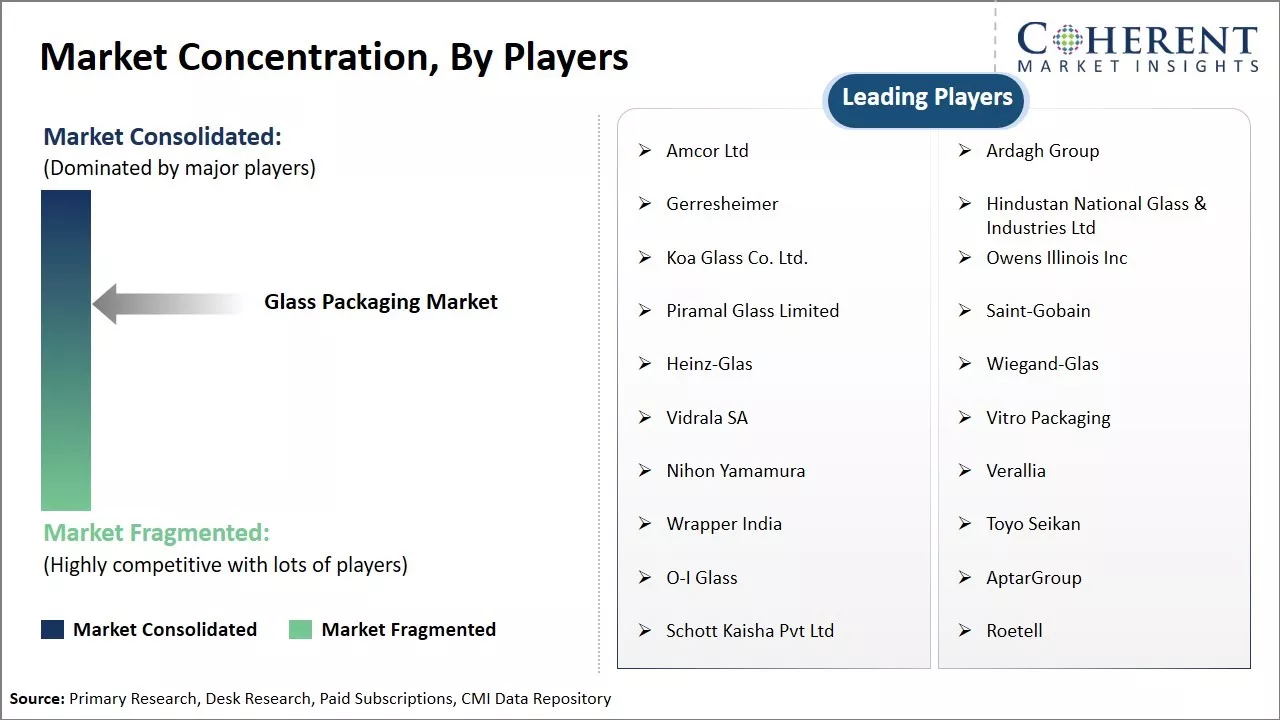
Get actionable strategies to beat competition: Request sample copy
Changing Consumer Lifestyle and PreferencesThe busy lifestyles and growing disposable incomes of urban consumers have spurred the demand for convenient and on-the-go food and beverage consumption. For instance, Gross national disposable income is expected to expand 8.9% in FY24 and 14.5% in FY23. Ready-to-eat meals, snacks, and smaller glass packaging sizes are gaining immense traction. At the same time, health and wellness trends have also accelerated the sales of bottled water, juices, and other packaged beverages instead of soft drinks. Glass is an ideal format for showcasing the purity and protection of contents in these segments. The transparent glass material allows full product visibility to attract consumers. Manufacturers are innovating attractive designs, shapes and decors along with easy opening closures to make glass jars & bottles more portable and user-friendly. At the same time, premium alcoholic beverage producers still prefer glass containers imparting a premium image to the products and preventing light/oxygen permeability issues compared to plastics. With consumers increasingly valuing branding and aesthetics along with functionality, glass packaging presents a great canvas for brands engage with them effectively with minimal design changes. These evolving consumer needs are driving more brands to leverage glass packaging across food and beverage categories to enhance the shelf-appeal, attract new buyers and build loyalty.
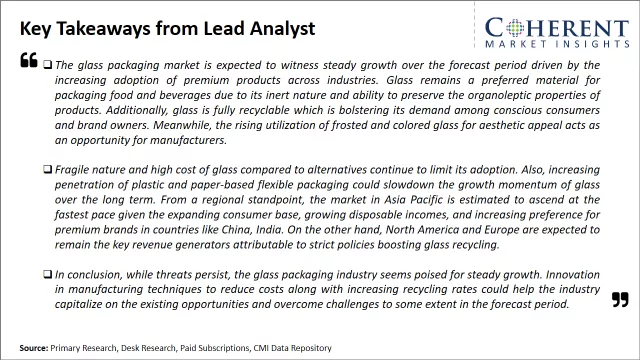
To learn more about this report, Request sample copy
Market Challenges: Increasing Preference of Consumers towards Lightweight and Sustainable Packaging
One of the major challenges faced by the glass packaging market is the increasing preference of consumers for lightweight and sustainable packaging formats like plastics. Plastics provide advantages over glass in terms of cost, weight, and durability in handling and transportation. Strict environmental legislations related to glass recycling and disposal are also challenging glass producers. High energy consumption in glass manufacturing results in high carbon footprint, encouraging buyers to switch to greener packaging alternatives. Rising raw material prices make glass packaging costlier compared to other materials.
Market Opportunities: Growing Demand for Premium Alcoholic Beverages
The glass packaging market sees opportunities in segments like premium alcoholic beverages and beauty products which require the barrier protection, transparency, and weightiness attributes of glass. Rising health-consciousness fuel the demand for glass as a natural and chemical-free packaging material.
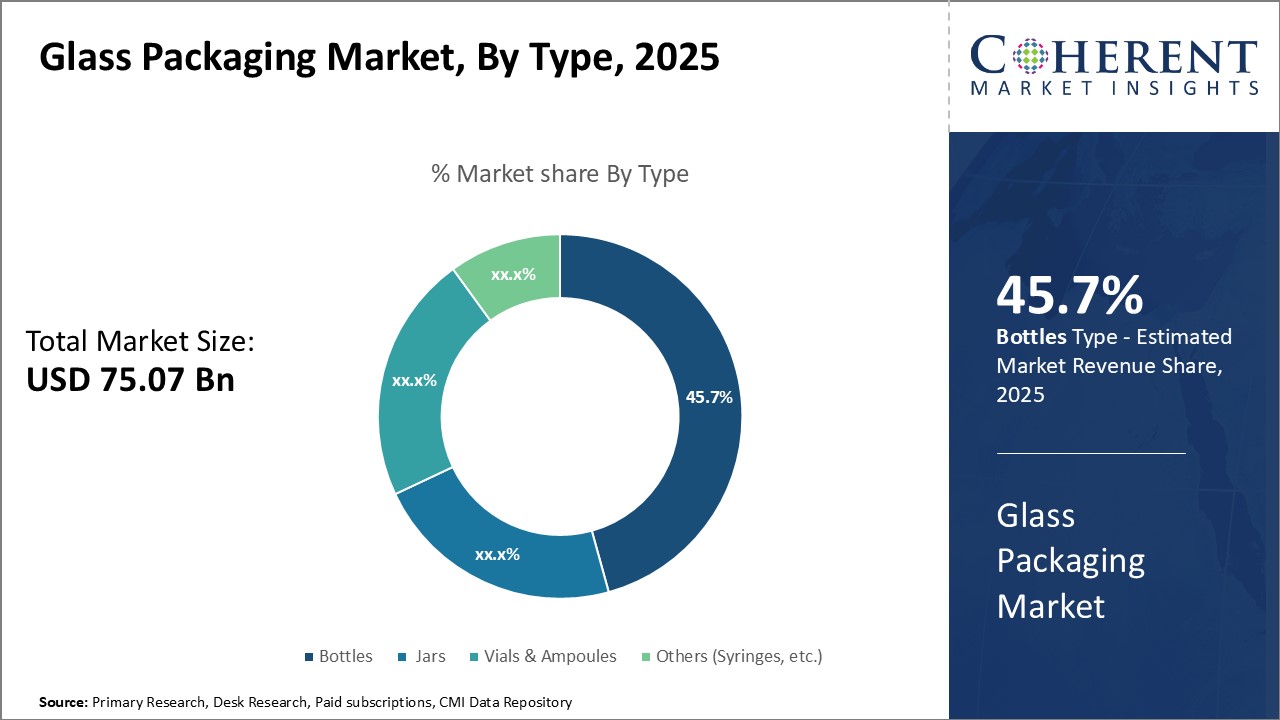
Discover high revenue pocket segments and roadmap to it: Request sample copy
Insights, By Type: In terms of Type, Bottles contributes the highest share of the market owing to its widespread applications
Bottles dominate the glass packaging market due to their versatility and utility across many industries with 45.7% share. As the most common form of glass container for both commercial and household use, bottles fulfill essential packaging needs for beverages, food items, cosmetics and more. Their advantages over alternative packaging types like plastic include barrier properties that keep contents fresher for longer as well as an image of premium quality and recyclability that resonates with health-conscious and environmentally aware consumers. One of the greatest drivers of bottle demand is the beverage industry, where they are indispensable for packaging water, juices, beers, wines and spirits for mass retail markets. Bottles efficiently seal and preserve the organoleptic properties of liquids while allowing easy dispensing. Their shape and size options across narrow-neck, wide-mouth and PET bottle variants satisfy diverse beverage categories. Bottles also possess screw caps, pumps and trigger sprays that provide optimized dispensing solutions according to product type. Significant research into bottle design customization by manufacturers further encourages brand loyalty and repeat sales within the competitive beverage sector.
Insights, By End-use Industry: In terms of Application, Food & Beverages contributes the highest share of the market owing to changing consumer habits
In terms of Application, Food & Beverages contributes the 44.4% share of the market owing to changing consumer habits. The food and beverage industry makes extensive use of glass packaging owing to changing consumer habits and preferences. Glass remains the preferred material for packaging various food items and beverages due to its inert and non-reactive properties. Glass does not leach chemicals into contents and provides a complete barrier from external contaminants, making it suitable for packaging a wide range of food and drink products. Glass is heavily utilized for bottling beer due to the material's durability and versatility. Beer producers favor glass as it keeps beer fresher for longer by completely blocking out light. This allows brewers to showcase the color and brand of different beers vibrantly. Glass bottles are also 100% recyclable and have a high reusability rate in the beer industry. Manufacturers can design innovative glass bottles separately for each brand, giving them a unique selling proposition in stores. Another major application of glass is in the bottling of wine and spirits. Glass is considered the ideal material for wine bottles as it does not influence the taste or aroma of the contents. The material also resists chemical interactions, maintaining the quality and flavor profile of wine over several years. Premium spirit brands extensively use specific glass bottle designs to complement their luxury positioning. Glass enhances the consumer experience, engagement and perception of superior quality for such premium food and beverage products. Growing food industry is expected to drive the segment growth. For instance, according to data published by Invest India in 2022, by 2025 the Indian Food Processing market is estimated to reach US$ 535 Bn, growing at a compound annual growth rate of 15.2%.
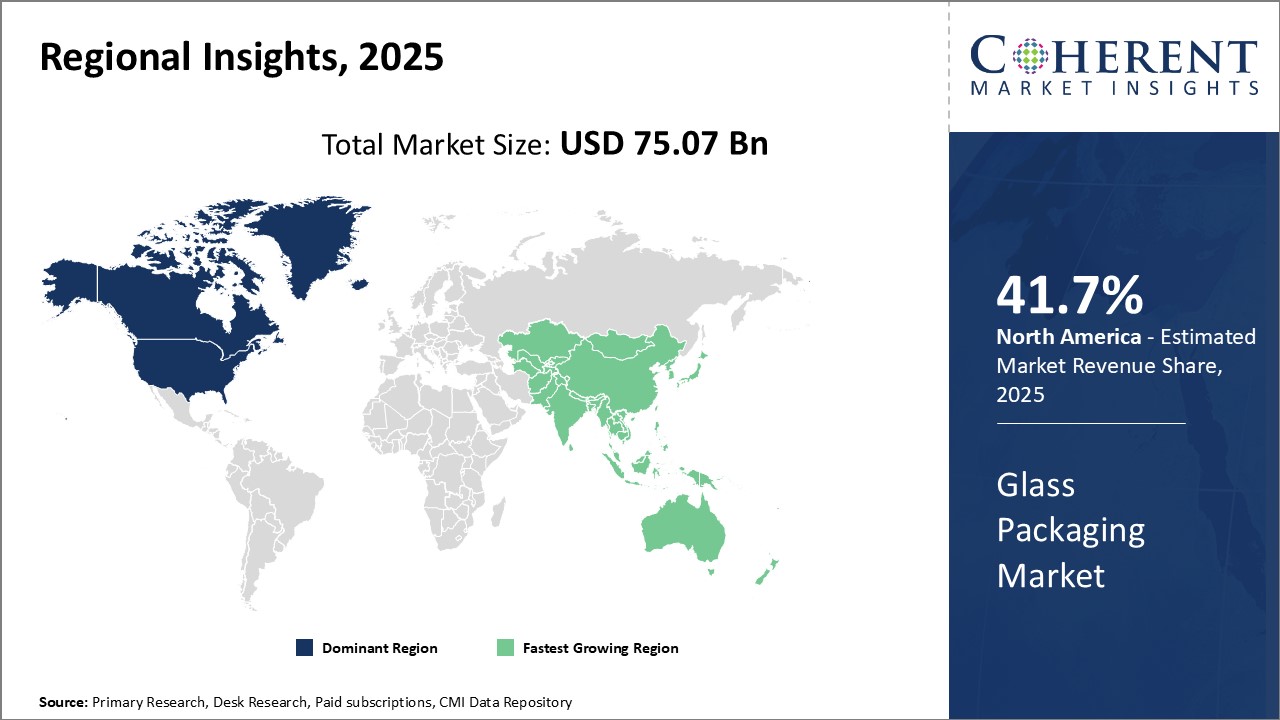
Need a Different Region or Segment? Customize now
North America has established itself as the dominant region in the global glass packaging market with 41.7% share. The U.S., in particular, has a large and well-established food and beverage industry that relies heavily on glass packaging solutions. Many American brands are household names worldwide and their preference for glass packaging has helped cement its popularity. The region also has a highly integrated and sophisticated supply chain for glass packaging. Major glass manufacturers have production facilities spread across the region to ensure just-in-time delivery for customers. This reliable supply infrastructure and proximity to demand centers has reinforced North America's leadership position. Additionally, glass recycling is widely practiced due to initiatives by both the government and packaging firms. The high recycling rates lower costs for glass producers and improve the sustainability of glass packaging.
One region that has emerged as the fastest growing market for glass packaging is South Asia. India in specific has seen tremendous surge in demand for packaged consumer goods like foods, beverages, cosmetics and pharmaceuticals in line with rising disposable incomes. Both international and domestic companies have extensively expanded their manufacturing footprint in India to cater to this new consumer class. The glass packaging localization drives have also gathered steam. Global firms have partnered with local partners to set up glass packaging plants within India to ensure secure supply sources. This type of backward integration is proving beneficial to strengthen supply chains. Meanwhile, Indian glass makers are increasingly adopting advanced technologies and investing in automation to boost efficiencies. The industry presents immense opportunities for firms that can satisfy the evolving needs of Indian consumers and consistently deliver high-quality glass products at competitive rates.
Glass Packaging Market Report Coverage
| Report Coverage | Details | ||
|---|---|---|---|
| Base Year: | 2024 | Market Size in 2025: | USD 75.07 Bn |
| Historical Data for: | 2020 To 2024 | Forecast Period: | 2025 To 2032 |
| Forecast Period 2025 to 2032 CAGR: | 4.3% | 2032 Value Projection: | USD 100.87 Bn |
| Geographies covered: |
|
||
| Segments covered: |
|
||
| Companies covered: |
Amcor Ltd, Ardagh Group, Gerresheimer, Hindustan National Glass & Industries Ltd, Koa Glass Co. Ltd., Owens Illinois Inc, Piramal Glass Limited, Saint-Gobain, Heinz-Glas, Wiegand-Glas, Vidrala SA, Vitro Packaging, Nihon Yamamura, Verallia, Wrapper India, Toyo Seikan, O-I Glass, AptarGroup, Schott Kaisha Pvt Ltd, and Roetell |
||
| Growth Drivers: |
|
||
| Restraints & Challenges: |
|
||
Uncover macros and micros vetted on 75+ parameters: Get instant access to report
*Definition: The glass packaging market consists of companies that manufacture glass packaging products including glass bottles, jars, vials, ampoules, and other containers used for packaging food and beverages, pharmaceuticals, cosmetics, and other consumer and industrial goods. Glass is a highly favored material for packaging due to its recyclability and ability to preserve product quality and safety by preventing oxygen, moisture, ultraviolet light, and bacteria from degrading the contents inside.
Type Insights (Revenue, USD Bn, 2020 - 2032)
Share
Share
About Author
Kalpesh Gharte is a senior consultant with approximately 5 years of experience in the consulting industry. Kalpesh holds an MBA in Operations and Marketing Management, providing him with a strong foundation in market strategy and analysis. He has contributed to various consulting and syndicated reports, delivering valuable insights that support informed business decisions
Missing comfort of reading report in your local language? Find your preferred language :
Transform your Strategy with Exclusive Trending Reports :
Frequently Asked Questions
Joining thousands of companies around the world committed to making the Excellent Business Solutions.
View All Our Clients
US Reciprocal Tax Impact Analysis On Glass Packaging Market
Stay updated on tariff changes with expert insights and timely information